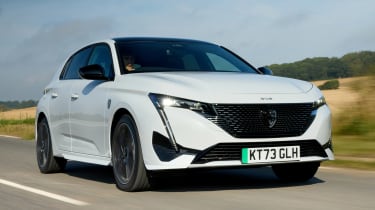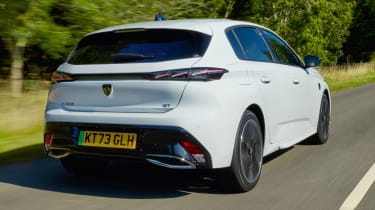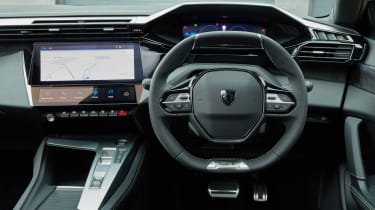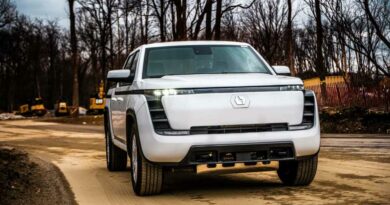New Peugeot E-308 2023 review
The new Peugeot E-308 carries over the strength of its combustion-engined sibling, but it looks expensive compared to its rivals
3.5 out of 5
How we review carsBuy used for less at Buyacar
Verdict
In its transition from an internal combustion-engined hatch to a fully electric one, Peugeot has managed to carry over the strengths of the 308 into a package which is now quieter, smoother and more pleasant to drive. Yet while it feels like a higher-quality product than many of its rivals, other figures, particularly battery capacity and range, don’t stack up – especially when much of the competition is less expensive.
This is the new Peugeot E-308, the all-electric version of the brand’s stylish family hatchback. It’s the French maker’s answer to the Volkswagen ID.3 and Renault Megane E-Tech, but also has to stand its ground against the bargain MG4.
It has a competitor much closer to home, too: the Vauxhall Astra Electric has recently joined the ever-growing range of five-door EV hatchbacks, but under the skin, the pair are very closely related.
Both cars use the Stellantis eVMP architecture – a structure adapted from the existing 308 platform to accommodate full battery-powered vehicles – and both get the same motor and battery configurations. That means the E-308 uses a 54kWh battery that Peugeot claims is good for a range of up to 267 miles, with 100kW charging allowing for a charge rate of 10-80 per cent in around 30 minutes.
More reviews
Car group tests
- Peugeot 308 SW vs Skoda Octavia Estate: 2022 twin test review
- Peugeot 308 vs Kia Ceed vs Volkswagen Golf: 2022 group test review
- Peugeot 308 review
- Peugeot 308 SW Hybrid: long-term test review
- New Peugeot 308 diesel 2023 review
- New Peugeot 308 Hybrid 180 2022 review
- New Peugeot 308 SW 2022 review
In-depth reviews
Long-term tests
Road tests
That battery supplies energy to an electric motor driving the front wheels. Depending on the drive mode you choose, the power output varies. In Eco mode, there’s 108bhp and 220Nm of torque; Normal mode lifts those numbers to 134bhp and 220Nm, while Sport introduces the maximum 156bhp and 270Nm.
However, even in that most potent mode, the E-308 falls short of many rivals. The ID.3 family kicks off with a 201bhp rear-drive motor, and a 58kWh battery (a 77kWh pack is also available), and the Megane delivers 217bhp with a 60kWh battery. The MG4 Extended Range has the most promising on-paper figures of all, with 242bhp and a 74.4kWh battery.
So the Peugeot will need to fight back in other areas, and one place where it emphatically manages to beat the competition is with regards to cabin design and quality. The layout is near-identical to the petrol, diesel and plug-in hybrid versions of the 308, and beside its all-electric rivals, the swooping dashboard, which uses a mix of squidgy plastics and fabric coverings across its surface, feels much more expensive. It even gives premium petrol hatchbacks from BMW and Mercedes a run for their money – and looks more distinctive than either.
While there’s no faulting the finish, in other areas the 308’s insides aren’t a complete success. Firstly there’s rear seat space, which is much more cramped than its rivals – especially the Volkswagen – and a 361-litre boot is merely average for the class.
The ergonomics aren’t perfect, either. A dual touchscreen arrangement works well enough; the main display looks great, loads fairly quickly, and is supplemented by a secondary panel below, which the driver can configure to show the shortcuts of their choosing. We’d like it even more, however, if you could configure them to show the climate controls on a more permanent basis, as they are one of the features confined to the main 10-inch display.
The odd wheel has a bearing on the driving experience, too. There’s plenty of assistance; great around town where it feels very light, but that makes it short on feedback when you’re on more open roads. Once you’re used to it, the 308 remains fairly capable, if uneventful, to drive. It doesn’t feel significantly more lethargic than plug-in hybrid versions of the 308 (there’s only a 51kg weight increase from PHEV to EV), but the 308 doesn’t have the sweet balance of ride and handling of the best in the class; the Megane feels sharper through the turns, and the MG is more fun overall. Noise isolation over bumps and poor surfaces is excellent in the 308, though, and the ride, though slightly firm, isn’t harsh.
Like most EVs, the electric powertrain is very smooth, quiet and makes the 308 a doddle to drive. We did find that Sport was the mode we used most often – not because it offers the maximum power, but because the throttle response feels a little lazy in the Eco and Normal settings.
Even so, the 308 doesn’t have the immediacy away from the line that we’ve experienced in many other EVs, and performance lags behind the competition. Still, with maximum torque available from any speed, the E-308 feels a little livelier than the 9.8-second 0-62mph dash suggests.
Prices for the E-308 start from £40,050 in Allure trim, climbing to £42,250 for the range-topping GT model driven here. A base Volkswagen ID.3 costs from £37,255 and a Megane starts at £36,995. The MG, with the strongest stats of the bunch – though admittedly the cheapest-feeling cabin, too – costs just £36,495.
On a three-year PCP deal with a £5,000 deposit and 10,000-mile annual limit, the Peugeot E-308 in Allure trim comes to £516 per month, while the Megane weighs in at £478 per month. Match the pair up in their top trims and costs swing slightly in the Peugeot’s favour, but that’s before we come to the fact that if you’re able to stump up a 20 per cent deposit (at least £7,399), the Megane is available with zero per cent finance, making it even more competitive. The MG4 is also available with a zero per cent deal, albeit on a two-year agreement.
| Model: | Peugeot E-308 GT |
| Price: | £42,250 |
| Powertrain: | 54kWh battery/1x e-motor |
| Power/torque: | 156bhp/270Nm |
| Transmission: | Single-speed automatic, front-wheel drive |
| 0-62mph: | 9.8 seconds |
| Top speed | 106 mph |
| Range: | 255 miles |
| Charging: | 100kW (10-80% in 30 mins) |
| Size (L/W/H): | 4,365/1,850/1,465mm |
| On sale: | Now |
Source: Read Full Article







